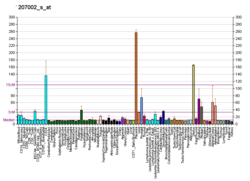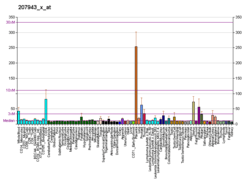PLAGL1
Zinc finger protein PLAGL1 is a protein that in humans is encoded by the PLAGL1 gene.[5][6][7]
Function
This gene encodes a C2H2 zinc finger protein with transactivation and DNA-binding activity. This gene has been shown to exhibit antiproliferative activities and is a tumor suppressor gene candidate. Many transcript variants encoding two different isoforms have been found for this gene.[7]
Interactions
PLAGL1 has been shown to interact with P53.[8]
gollark: Apologies.
gollark: Oh yes, for obvious safety reasons.
gollark: Can it be used for transactions *directly* relating to pigeons?
gollark: You're DEFINITELY not in GTech™ alternate universe 1289571-β-β-β.
gollark: We will convert any of these into currency units at the objectively correct price.
References
- GRCh38: Ensembl release 89: ENSG00000118495 - Ensembl, May 2017
- GRCm38: Ensembl release 89: ENSMUSG00000019817 - Ensembl, May 2017
- "Human PubMed Reference:". National Center for Biotechnology Information, U.S. National Library of Medicine.
- "Mouse PubMed Reference:". National Center for Biotechnology Information, U.S. National Library of Medicine.
- Kas K, Voz ML, Hensen K, Meyen E, Van de Ven WJ (Oct 1998). "Transcriptional activation capacity of the novel PLAG family of zinc finger proteins". J. Biol. Chem. 273 (36): 23026–32. doi:10.1074/jbc.273.36.23026. PMID 9722527.
- Varrault A, Ciani E, Apiou F, Bilanges B, Hoffmann A, Pantaloni C, Bockaert J, Spengler D, Journot L (Aug 1998). "hZAC encodes a zinc finger protein with antiproliferative properties and maps to a chromosomal region frequently lost in cancer". Proc. Natl. Acad. Sci. U.S.A. 95 (15): 8835–40. doi:10.1073/pnas.95.15.8835. PMC 21163. PMID 9671765.
- "Entrez Gene: PLAGL1 pleiomorphic adenoma gene-like 1".
- Huang SM, Schönthal AH, Stallcup MR (Apr 2001). "Enhancement of p53-dependent gene activation by the transcriptional coactivator Zac1". Oncogene. 20 (17): 2134–43. doi:10.1038/sj.onc.1204298. PMID 11360197.
Further reading
- Vernon M (2005). "Fifty years of research on the intelligence of deaf and hard-of-hearing children: a review of literature and discussion of implications". J Deaf Stud Deaf Educ. 10 (3): 225–31. doi:10.1093/deafed/eni024. PMID 15888725.
- Abdollahi A, Roberts D, Godwin AK, Schultz DC, Sonoda G, Testa JR, Hamilton TC (1997). "Identification of a zinc-finger gene at 6q25: a chromosomal region implicated in development of many solid tumors". Oncogene. 14 (16): 1973–9. doi:10.1038/sj.onc.1201034. PMID 9150364.
- Abdollahi A, Godwin AK, Miller PD, Getts LA, Schultz DC, Taguchi T, Testa JR, Hamilton TC (1997). "Identification of a gene containing zinc-finger motifs based on lost expression in malignantly transformed rat ovarian surface epithelial cells". Cancer Res. 57 (10): 2029–34. PMID 9158001.
- Spengler D, Villalba M, Hoffmann A, Pantaloni C, Houssami S, Bockaert J, Journot L (1997). "Regulation of apoptosis and cell cycle arrest by Zac1, a novel zinc finger protein expressed in the pituitary gland and the brain". EMBO J. 16 (10): 2814–25. doi:10.1093/emboj/16.10.2814. PMC 1169890. PMID 9184226.
- Abdollahi A, Bao R, Hamilton TC (1999). "LOT1 is a growth suppressor gene down-regulated by the epidermal growth factor receptor ligands and encodes a nuclear zinc-finger protein". Oncogene. 18 (47): 6477–87. doi:10.1038/sj.onc.1203067. PMID 10597250.
- Kamiya M, Judson H, Okazaki Y, Kusakabe M, Muramatsu M, Takada S, Takagi N, Arima T, Wake N, Kamimura K, Satomura K, Hermann R, Bonthron DT, Hayashizaki Y (2000). "The cell cycle control gene ZAC/PLAGL1 is imprinted--a strong candidate gene for transient neonatal diabetes". Hum. Mol. Genet. 9 (3): 453–60. doi:10.1093/hmg/9.3.453. PMID 10655556.
- Bilanges B, Varrault A, Mazumdar A, Pantaloni C, Hoffmann A, Bockaert J, Spengler D, Journot L (2001). "Alternative splicing of the imprinted candidate tumor suppressor gene ZAC regulates its antiproliferative and DNA binding activities". Oncogene. 20 (10): 1246–53. doi:10.1038/sj.onc.1204237. PMID 11313869.
- Huang SM, Schönthal AH, Stallcup MR (2001). "Enhancement of p53-dependent gene activation by the transcriptional coactivator Zac1". Oncogene. 20 (17): 2134–43. doi:10.1038/sj.onc.1204298. PMID 11360197.
- Mackay DJ, Coupe AM, Shield JP, Storr JN, Temple IK, Robinson DO (2002). "Relaxation of imprinted expression of ZAC and HYMAI in a patient with transient neonatal diabetes mellitus". Hum. Genet. 110 (2): 139–44. doi:10.1007/s00439-001-0671-5. PMID 11935319.
- Abdollahi A, Pisarcik D, Roberts D, Weinstein J, Cairns P, Hamilton TC (2003). "LOT1 (PLAGL1/ZAC1), the candidate tumor suppressor gene at chromosome 6q24-25, is epigenetically regulated in cancer". J. Biol. Chem. 278 (8): 6041–9. doi:10.1074/jbc.M210361200. PMID 12473647.
- Hoffmann A, Ciani E, Boeckardt J, Holsboer F, Journot L, Spengler D (2003). "Transcriptional activities of the zinc finger protein Zac are differentially controlled by DNA binding". Mol. Cell. Biol. 23 (3): 988–1003. doi:10.1128/MCB.23.3.988-1003.2003. PMC 140694. PMID 12529403.
- Colland F, Jacq X, Trouplin V, Mougin C, Groizeleau C, Hamburger A, Meil A, Wojcik J, Legrain P, Gauthier JM (2004). "Functional proteomics mapping of a human signaling pathway". Genome Res. 14 (7): 1324–32. doi:10.1101/gr.2334104. PMC 442148. PMID 15231748.
- Ma D, Shield JP, Dean W, Leclerc I, Knauf C, Burcelin R, Rutter GA, Kelsey G (2004). "Impaired glucose homeostasis in transgenic mice expressing the human transient neonatal diabetes mellitus locus, TNDM". J. Clin. Invest. 114 (3): 339–48. doi:10.1172/JCI19876. PMC 484972. PMID 15286800.
- Cvetkovic D, Pisarcik D, Lee C, Hamilton TC, Abdollahi A (2004). "Altered expression and loss of heterozygosity of the LOT1 gene in ovarian cancer". Gynecol. Oncol. 95 (3): 449–55. doi:10.1016/j.ygyno.2004.08.051. PMID 15581945.
- Mitchell J, Punthakee Z, Lo B, Bernard C, Chong K, Newman C, Cartier L, Desilets V, Cutz E, Hansen IL, Riley P, Polychronakos C (2004). "Neonatal diabetes, with hypoplastic pancreas, intestinal atresia and gall bladder hypoplasia: search for the aetiology of a new autosomal recessive syndrome". Diabetologia. 47 (12): 2160–7. doi:10.1007/s00125-004-1576-3. PMID 15592663.
This article is issued from Wikipedia. The text is licensed under Creative Commons - Attribution - Sharealike. Additional terms may apply for the media files.






